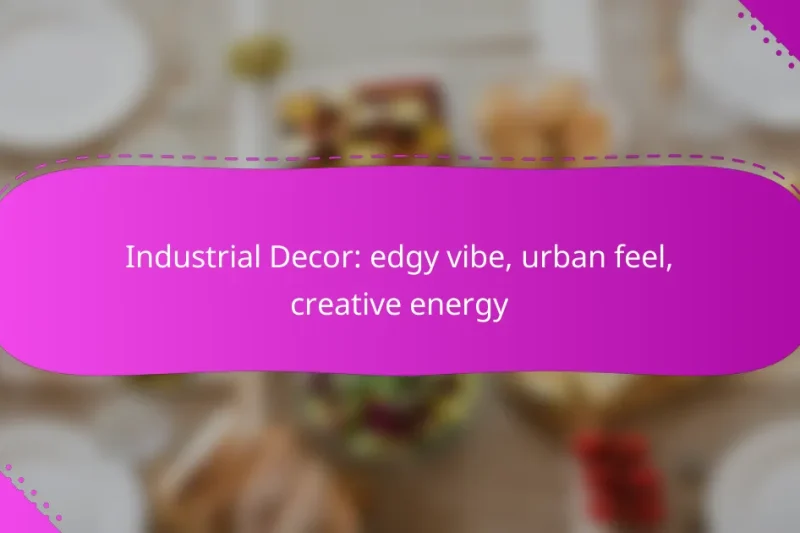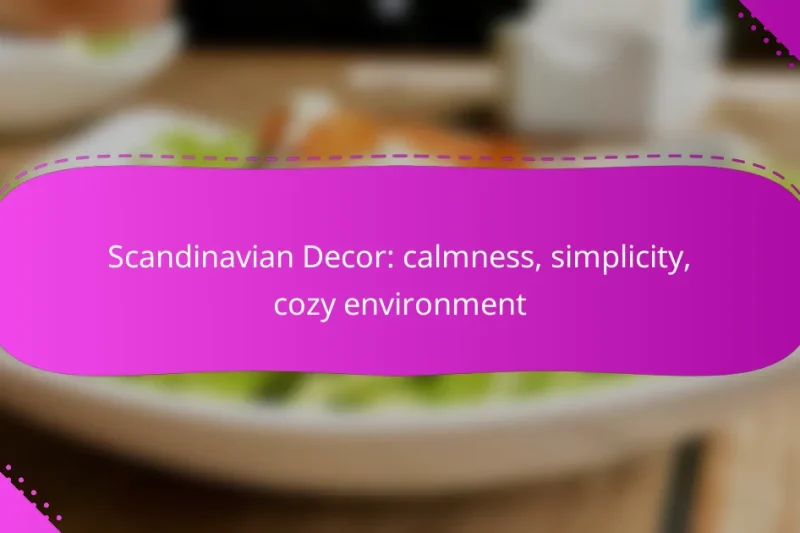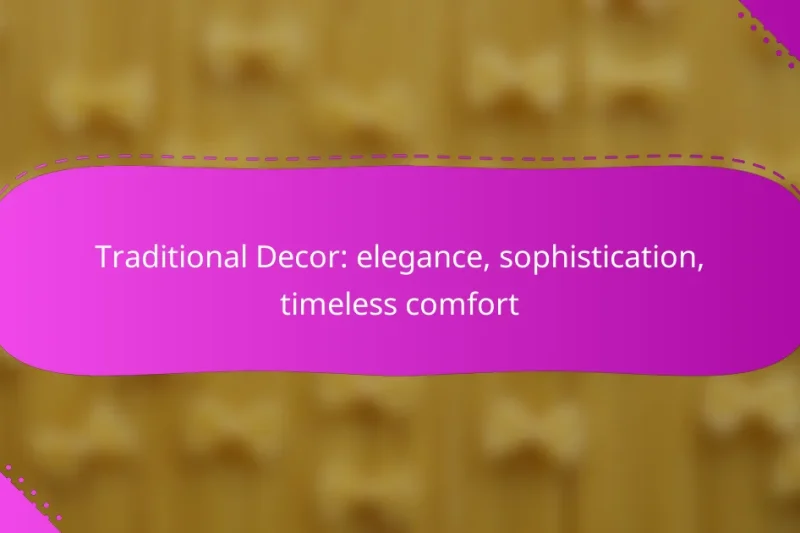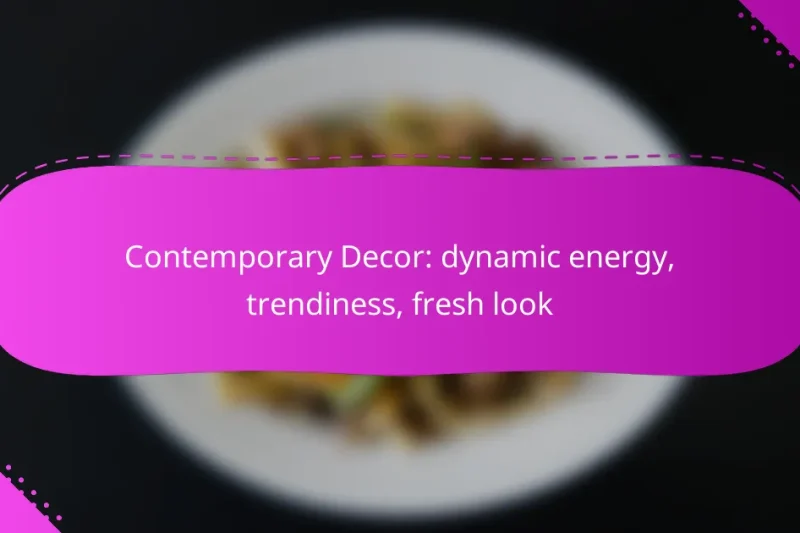Art Deco decor is a celebration of opulence and glamour, characterized by bold geometric shapes and … Art Deco Decor: opulence, glamour, striking visualsRead more
The Impact of Decor Styles on Home Atmosphere
Decor styles play a pivotal role in shaping the atmosphere of homes, influencing how spaces feel and function. Each style contributes unique elements that can evoke various emotions, from warmth and calmness to energy and elegance, ultimately affecting the mood and experience of the inhabitants.
Industrial Decor: edgy vibe, urban feel, creative energy
Industrial decor embodies an edgy vibe and urban feel, drawing inspiration from the raw aesthetics of … Industrial Decor: edgy vibe, urban feel, creative energyRead more
Scandinavian Decor: calmness, simplicity, cozy environment
Scandinavian decor embodies a harmonious blend of calmness and simplicity, creating a cozy environment that invites … Scandinavian Decor: calmness, simplicity, cozy environmentRead more
Traditional Decor: elegance, sophistication, timeless comfort
Traditional decor embodies elegance and sophistication, offering a timeless comfort that enhances any living space. By … Traditional Decor: elegance, sophistication, timeless comfortRead more
Contemporary Decor: dynamic energy, trendiness, fresh look
Contemporary decor embodies a fresh and dynamic energy, characterized by clean lines, bold colors, and a … Contemporary Decor: dynamic energy, trendiness, fresh lookRead more
How do decor styles influence home atmosphere in the UK?
Decor styles significantly shape the atmosphere of homes in the UK by affecting how spaces feel and function. Each style brings its own unique elements that can evoke warmth, calmness, energy, or elegance, influencing the overall mood and experience of the inhabitants.
Warmth of Rustic Decor
Rustic decor creates a cozy and inviting atmosphere through the use of natural materials like wood, stone, and earthy colors. This style often incorporates vintage or reclaimed furniture, which adds character and a sense of history to the space.
To enhance warmth, consider using soft textiles such as wool or cotton for throws and cushions. Incorporating elements like a fireplace or wood-burning stove can further amplify the rustic charm and comfort of your home.
Calmness of Minimalist Design
Minimalist design promotes a serene atmosphere by emphasizing simplicity and functionality. This style typically features clean lines, neutral color palettes, and uncluttered spaces, which help reduce visual noise and create a sense of peace.
To achieve a minimalist look, focus on essential furniture pieces and avoid excessive decoration. Utilizing natural light and open spaces can enhance the calming effect, making your home feel more spacious and tranquil.
Energy of Eclectic Styles
Eclectic styles infuse energy into a home by combining various design elements from different periods and cultures. This approach allows for personal expression and creativity, resulting in vibrant and dynamic spaces that reflect the homeowner’s personality.
To create an eclectic atmosphere, mix bold colors, patterns, and textures while ensuring that there is a cohesive element, such as a common color scheme or theme. This balance prevents the space from feeling chaotic and instead fosters a lively environment.
Elegance of Modern Decor
Modern decor exudes elegance through its sleek lines, sophisticated materials, and a focus on functionality. This style often incorporates high-quality finishes and a neutral color palette, creating a refined and polished atmosphere.
To achieve an elegant modern look, invest in statement furniture pieces and art that serve as focal points. Incorporating metallic accents or glass elements can add a touch of luxury, enhancing the overall aesthetic of your home.
What are the best decor styles for creating a cozy atmosphere?
The best decor styles for creating a cozy atmosphere include Cottage Style and Scandinavian Design. These styles emphasize warmth, comfort, and inviting elements that make a space feel like home.
Cottage Style
Cottage Style is characterized by its warm colors, rustic furnishings, and a mix of vintage and handmade elements. This decor style often incorporates floral patterns, soft textiles, and natural materials like wood and stone, which contribute to a relaxed and inviting environment.
To achieve a Cottage Style atmosphere, focus on layering textures with throw blankets, cushions, and area rugs. Incorporating personal touches, such as family photos or heirloom pieces, can enhance the cozy feel. Aim for a color palette that includes soft pastels or earthy tones to create a soothing backdrop.
Scandinavian Design
Scandinavian Design emphasizes minimalism while still providing a warm and cozy atmosphere. This style typically features clean lines, functional furniture, and a neutral color palette accented by natural elements like wood and greenery.
To create a cozy Scandinavian space, prioritize natural light and open layouts. Use soft textiles, such as wool throws and plush cushions, to add warmth. Incorporating plants can also enhance the inviting feel, as they bring a touch of nature indoors. Aim for a balance between simplicity and comfort, avoiding clutter to maintain a serene environment.
How can color palettes enhance home atmosphere?
Color palettes play a crucial role in shaping the atmosphere of a home by influencing mood and perception. By selecting the right colors, homeowners can create spaces that feel more inviting, relaxing, or energizing, depending on their needs.
Warm Colors for Inviting Spaces
Warm colors, such as reds, oranges, and yellows, are known for creating a cozy and inviting atmosphere. These hues can stimulate conversation and foster a sense of comfort, making them ideal for living rooms and dining areas.
When using warm colors, consider balancing them with neutral tones to avoid overwhelming the space. For example, a warm beige wall paired with terracotta accents can create a welcoming environment without feeling too intense.
Cool Colors for Relaxation
Cool colors, including blues, greens, and purples, promote relaxation and tranquility. These shades are often used in bedrooms and bathrooms to create a calming retreat from daily stresses.
To effectively use cool colors, opt for softer shades like pastel blues or muted greens, which can enhance the soothing effect. Combining these colors with natural materials, such as wood or stone, can further enhance the peaceful atmosphere.
What role does furniture selection play in home atmosphere?
Furniture selection significantly influences the overall atmosphere of a home by affecting comfort, functionality, and aesthetic appeal. Choosing the right pieces can create a welcoming environment, enhance usability, and reflect personal style.
Comfortable Seating Options
Comfortable seating is essential for creating a relaxed atmosphere in any living space. Options such as plush sofas, ergonomic chairs, and cushioned benches can invite people to linger and enjoy their surroundings. When selecting seating, consider materials that offer both comfort and durability, such as leather or high-quality fabric.
Incorporating a variety of seating types can enhance versatility. For example, a mix of armchairs, ottomans, and sectional sofas can accommodate different activities, from casual gatherings to formal entertaining. Aim for a balance between style and comfort to ensure that the seating complements the overall decor.
Functional Layouts
A functional layout is crucial for maximizing space and ensuring that the home atmosphere feels open and inviting. Arranging furniture to facilitate movement and interaction can enhance the usability of a room. For instance, placing seating in a circular formation encourages conversation, while keeping pathways clear promotes a sense of flow.
When designing a layout, consider the purpose of each room. In living areas, prioritize social interaction by grouping seating around focal points like fireplaces or entertainment centers. In contrast, workspaces should be organized to minimize distractions and promote productivity. Always keep in mind the scale of furniture relative to the room size to avoid overcrowding.
How can lighting choices affect the mood of a room?
Lighting choices significantly influence the mood of a room by altering its ambiance and emotional impact. The right lighting can create feelings of warmth and comfort or promote focus and productivity, depending on the type and intensity used.
Soft Lighting for Intimacy
Soft lighting is ideal for creating a cozy and intimate atmosphere. This type of lighting often includes warm tones and lower intensities, which can make a space feel inviting and relaxing. Consider using table lamps, dimmable fixtures, or wall sconces to achieve this effect.
To enhance intimacy, aim for lighting that is around 200-300 lumens per fixture. Using multiple light sources at different heights can help distribute light evenly, reducing harsh shadows and creating a more welcoming environment.
Bright Lighting for Productivity
Bright lighting is essential for spaces where focus and productivity are key, such as home offices or kitchens. This type of lighting typically involves cooler tones and higher intensities, which can help reduce eye strain and improve concentration. LED bulbs with a color temperature of 4000K to 5000K are often recommended for these settings.
When designing a productive space, ensure that lighting is at least 500 lumens per square meter. Consider using overhead lights combined with task lighting to illuminate work areas effectively, making it easier to stay engaged and efficient.
What are the emerging trends in home decor styles?
Emerging trends in home decor styles focus on sustainability, technology integration, and personalization. Homeowners are increasingly seeking decor that reflects their values and enhances their living experience.
Sustainable Materials
Sustainable materials are becoming a cornerstone of modern decor, emphasizing eco-friendliness and longevity. Options like bamboo, reclaimed wood, and recycled metals not only reduce environmental impact but also add unique character to spaces.
When choosing sustainable materials, consider certifications such as FSC (Forest Stewardship Council) for wood products or GOTS (Global Organic Textile Standard) for textiles. These standards help ensure that materials are sourced responsibly and ethically.
Smart Home Integration
Smart home integration is revolutionizing how decor styles are experienced, blending aesthetics with functionality. Devices like smart thermostats, lighting systems, and security cameras can be seamlessly incorporated into decor without compromising style.
To effectively integrate smart technology, prioritize devices that complement your existing decor. For instance, choose smart bulbs that can change color to match your room’s palette or sleek smart speakers that blend into your design. Avoid clutter by opting for wireless solutions that maintain a clean look.




